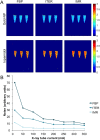Improved sensitivity of computed tomography towards iodine and gold nanoparticle contrast agents via iterative reconstruction methods
- PMID: 27185492
- PMCID: PMC4868985
- DOI: 10.1038/srep26177
Improved sensitivity of computed tomography towards iodine and gold nanoparticle contrast agents via iterative reconstruction methods
Abstract
Computed tomography is a widely used medical imaging technique that has high spatial and temporal resolution. Its weakness is its low sensitivity towards contrast media. Iterative reconstruction techniques (ITER) have recently become available, which provide reduced image noise compared with traditional filtered back-projection methods (FBP), which may allow the sensitivity of CT to be improved, however this effect has not been studied in detail. We scanned phantoms containing either an iodine contrast agent or gold nanoparticles. We used a range of tube voltages and currents. We performed reconstruction with FBP, ITER and a novel, iterative, modal-based reconstruction (IMR) algorithm. We found that noise decreased in an algorithm dependent manner (FBP > ITER > IMR) for every scan and that no differences were observed in attenuation rates of the agents. The contrast to noise ratio (CNR) of iodine was highest at 80 kV, whilst the CNR for gold was highest at 140 kV. The CNR of IMR images was almost tenfold higher than that of FBP images. Similar trends were found in dual energy images formed using these algorithms. In conclusion, IMR-based reconstruction techniques will allow contrast agents to be detected with greater sensitivity, and may allow lower contrast agent doses to be used.
Conflict of interest statement
T.I., A.D. and E.S. are employees of Philips Healthcare. D.P.C. is the recipient of research funding from Philips Healthcare.
Figures





References
-
- Ch. 4.2, Medical technologies, p83, accessed 15/04/2016. in Health at a Glance 2011: OECD Indicators (http://www.oecd.org/els/health-systems/49105858.pdf, 2011).
-
- Katzberg R. W. Contrast-induced nephropathy in 2010. Appl. Radiol. 39, 21–23 (2010).
-
- Earls J. P. et al.. Prospectively gated transverse coronary CT angiography versus retrospectively gated helical technique: Improved image quality and reduced radiation dose. Radiology 246, 742–753 (2008). - PubMed
-
- Saraste A., Nekolla S. G. & Schwaiger M. Cardiovascular molecular imaging: an overview. Cardiovasc. Res. 83, 643–652 (2009). - PubMed
Publication types
MeSH terms
Substances
Grants and funding
LinkOut - more resources
Full Text Sources
Other Literature Sources
Medical
Miscellaneous

